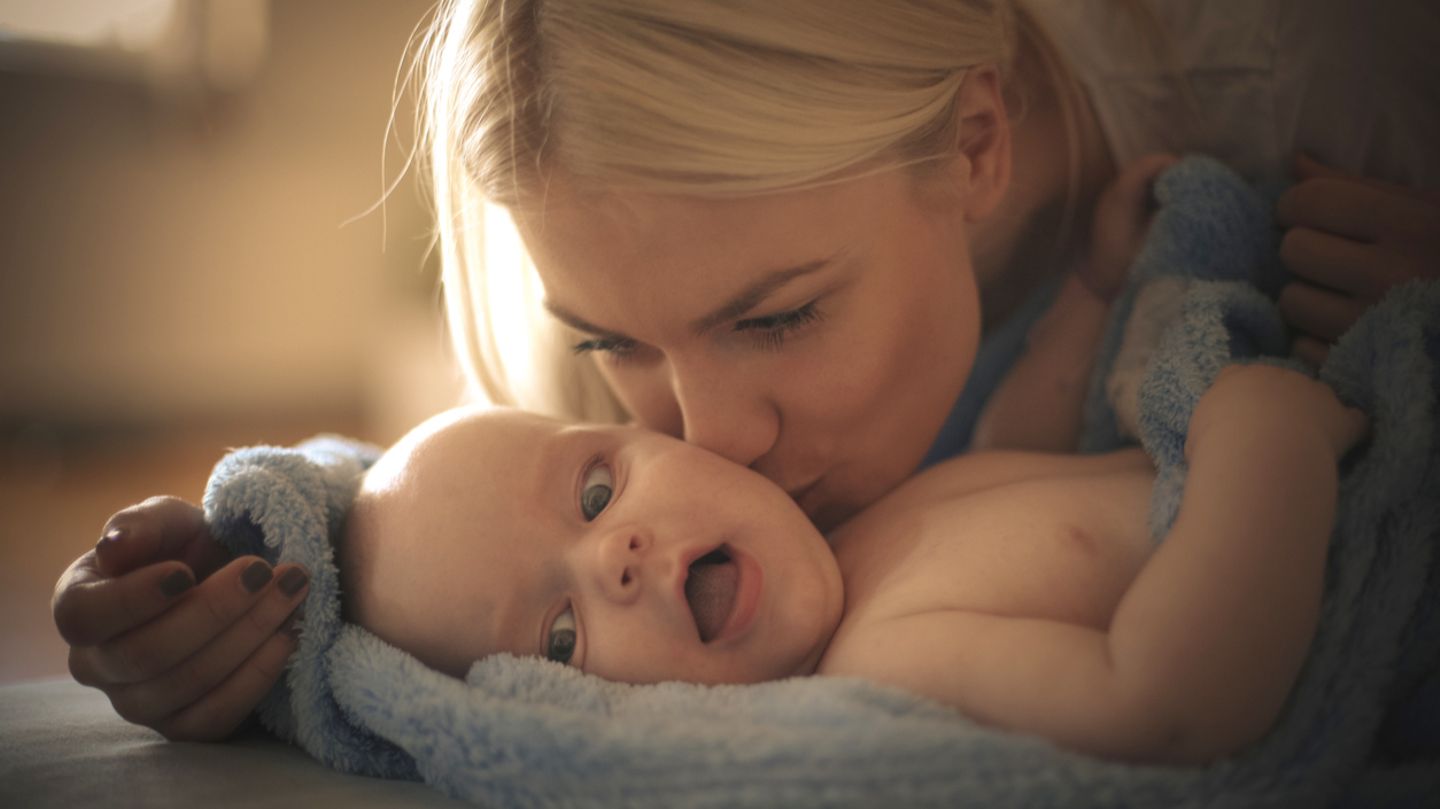
Baby care: Frequently asked questions about baby care
How much care does my baby need and what can we safely do without? Here you will find answers to ten frequently asked questions about baby care.
Hygiene is a must, but of course you also want to avoid too much of a good thing. If you’re wondering what’s important when it comes to baby care, you’ll find all the important information here.
Do I need bath additives for my baby’s bath?
The most important thing first: the best way to care for a baby is warm water. Healthy baby skin does not need bath additivesbecause soap and some bubble bath additives strain the acid mantle and dry out the skin even more. For children who already have dry skin, you can add two to three drops of wheat germ oil to the bath water (here you can find out everything about dry skin in babies and atopic dermatitis in babies). If you are breastfeeding, you can also add a little pumped or expressed breast milk to the bath water. This is good for sensitive baby skin. If you like, you can buy special bath oils for baby care.
Is a quick wash enough for baby care?
Yes, because babies are not actually dirty. It is enough to gently rub your child with a washcloth without soap to protect the acid mantle. Pay attention to the many small folds of skin. Skin flakes often collect on the neck, under the armpits and in the groin, which should be wiped off regularlyOtherwise the skin there can become inflamed. If your child has sensitive skin, you can also rub these areas with a little baby oil. To do this, simply put a little oil on your fingers and then gently run it along the folds of skin.
Some children enjoy being gently blow-dried after washing. However, this dries out the skin and should therefore only be done occasionally. And be careful: warm air relaxes babies, so they sometimes suddenly start peeing. To ensure that no urine stream hits the hairdryer, especially in boys, please always cover the abdomen with a diaper or a small towel or stand far enough away.
How do I care for a sore bottom?
The baby’s bottom is bright red and your child moans as soon as you touch the irritated areas in the diaper area? This could be diaper dermatitis! wonderful butt is of course not nice, but unfortunately it cannot always be prevented. Urine and stool irritate the delicate baby skin. Therefore: Make sure the diapers are highly absorbent or change your child more often than usual and clean the baby’s bottom with pure water.
If possible, give your child plenty of diaper-free time and let him or her kick around in a heated room without diapers. This is the best way for the skin to heal. If you are out and about and your baby has to wear a diaper, put some healing wool in the diaper to ensure good ventilation. The best way to clean it is to use perfume-free oil wipes. Healing ointments and wound protection creams such as marigold ointment or zinc ointment also support the healing process.
Important: If the skin in the diaper area is wet and small lumps form that curl up at the edges, it is best to see your pediatrician. Your baby may have a fungal infection (diaper rash).
5 images
How long can my newborn bathe?
According to the latest international guidelines, there is no increased risk of infection if newborns are bathed before the umbilical cord has fallen off and the navel has completely healed. However, newborns should not be bathed immediately after birth, so that the valuable vernix caseosa is not washed away. It contains substances that protect and care for the newborn’s skin.
Because the skin of newborns is only one fifth as thick as that of adults, it is very sensitive. Therefore, it is better not to bathe your baby for longer than ten minutes during the first year of life. Toddlers over one year old can splash around in the water for longer. How often you bathe your child is entirely up to you. Bathing is not a must. If your little one likes bathing and does not tend to have dry skin, he or she can bathe more often. If he or she is one of those children who does not like bathing, do not worry. It is enough to rub your baby down with a washcloth every now and then. This also protects the acid mantle.
What can I do about severe dandruff?
Many parents find the thick, sticky layer of scales that forms on the scalp of many babies unsightly. But there is no reason to worry: The scales are completely harmless and only form until the sebaceous glands are working properly. If you don’t want to wait, you can dab the affected areas of skin with perfume-free baby oil or olive oil, leave it for an hour, and then carefully remove the deposits with a comb. Then wash the head with lukewarm water.
Reading tip: Skin problems in babies: Is it cradle cap or chondrocyte granuloma?
Why does my child have pimples?
In the last months of pregnancy, the mother’s body produces hormones that promote the maturation of the baby’s lungs and the development of the immune system. However, they also cause the sebaceous glands in the child’s skin to become blocked. The result: newborn acne. Little boys have to deal with this slightly more often than girls. The skin does not need any special care.
Parents should also please not squeeze the pimples. This hurts the baby and can lead to unpleasant inflammation. It is best to avoid using perfumed care products as long as your child’s face looks like a crumb cake. Otherwise, just wait. Newborn acne usually goes away two to three months after birth.
How do I care for my baby’s hair?
Babies don’t actually need shampoo at all. Their fine hair can be washed easily when bathing and is cared for and clean with or without shampoo. A mild baby shampoo is only useful once the child’s hair has become thicker. It is gentler on the scalp than shampoo for adults and does not sting the eyes. However, when washing, make sure to hold your child’s head back so that shampoo and water do not run into the eyes. Dry the hair well after bathing so that your little one does not catch a cold.
How warm should the bath water be for baby care?
Your child’s body is only able to regulate heat through the skin from the age of two. That’s why it’s important that babies are nice and warm when bathing. It’s best to heat the bathroom to a cozy 24 degrees. Make sure that windows and doors are closed so that your child doesn’t get any drafts. The bath water shouldn’t be too hot or too cold. A temperature of around 37 degrees is ideal.
Tip: It’s best to buy a special bath thermometer from a drugstore. This is the easiest way to check the water temperature.
What is the best way to cut my child’s fingernails and toenails?
In the first few weeks after birth, the nails are usually still so soft that you can simply carefully pluck off any protruding edges. A little later, however, babies sometimes have very sharp nails with which they can inflict unsightly and painful scratches on themselves. Parents can soften the small, soft nails a little with rounded nail scissors, which are available in drugstores specifically for babies. This works best when the child is sleeping. Hold the little hand firmly at the front of the fingers and perhaps press the fingertips down a little. This will make it easier to reach the nail with the scissors. When cutting your fingernails, try to follow the slight semicircle of the natural nail shape. Please do not clean dark edges with the tip of a file. This could damage the soft nail bed.
How can I care for the ears and eyes?
When it comes to caring for little baby ears, less is actually more. Because: Ears have a so-called self-cleaning function. Earwax comes out of the ear slowly but steadily and can then be easily rubbed out of the ear using a thin paper towel or the corner of a towel. Cotton swabs are unnecessary and even unsuitable for babies, as little ones often move jerkily. If a cotton swab is then inserted into the ear, the eardrum can be damaged. Apart from that, earwax is often pushed deeper into the ear canal by cotton swabs. At some point, a plug can form that then closes the ear canal and has to be flushed out by the pediatrician.
Does your child’s eyes stick together after sleeping? This is often because the tear glands are not working properly after birth and the tear ducts, through which fluid drains from the eyes, are not yet fully developed. To remove plaque or small crusts from the eyes, parents can twist cotton wool between their thumb and index finger to form a stick. Dip it in boiled, cool water and use it to wipe off the plaque. Important: please always wipe from the outside to the inside.
Tip: If you are breastfeeding, you can also put some breast milk on the cotton wool. It is a real miracle cure, even for baby care. It loosens the adhesions and also has an anti-inflammatory effect.
Sources:
- Blume-Peytavi, U., Lavender, T., Jenerowicz, D., Ryumina, I., Stalder, J.-F., Torrelo, A. and Cork, MJ (2016), Recommendations from a European Roundtable Meeting on Best Practice Healthy Infant Skin Care. Pediatr Dermatol, 33: 311-321
- Children’s health.info: Body care from head to toe03.04.2022

Ethel Purdy – Medical Blogger & Pharmacist
Bridging the world of wellness and science, Ethel Purdy is a professional voice in healthcare with a passion for sharing knowledge. At 36, she stands at the confluence of medical expertise and the written word, holding a pharmacy degree acquired under the rigorous education systems of Germany and Estonia.
Her pursuit of medicine was fueled by a desire to understand the intricacies of human health and to contribute to the community’s understanding of it. Transitioning seamlessly into the realm of blogging, Ethel has found a platform to demystify complex medical concepts for the everyday reader.
Ethel’s commitment to the world of medicine extends beyond her professional life into a personal commitment to health and wellness. Her hobbies reflect this dedication, often involving research on the latest medical advances, participating in wellness communities, and exploring the vast and varied dimensions of health.
Join Ethel as she distills her pharmaceutical knowledge into accessible wisdom, fostering an environment where science meets lifestyle and everyone is invited to learn. Whether you’re looking for insights into the latest health trends or trustworthy medical advice, Ethel’s blog is your gateway to the nexus of healthcare and daily living.



